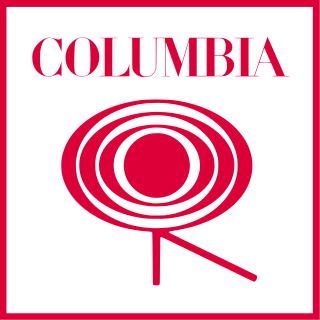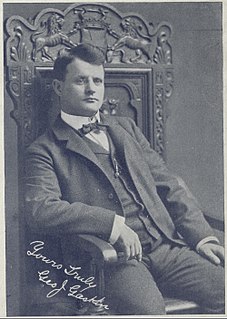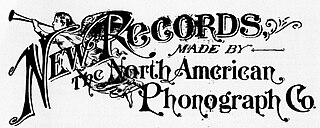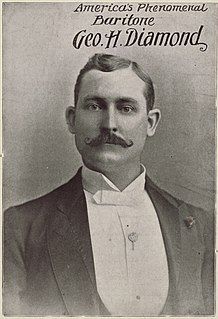
Columbia Records is an American record label owned by Sony Music Entertainment, a subsidiary of Sony Corporation of America, the North American division of Japanese conglomerate Sony. It was founded in 1887, evolving from the American Graphophone Company, the successor to the Volta Graphophone Company. Columbia is the oldest surviving brand name in the recorded sound business, and the second major company to produce records. From 1961 to 1990, Columbia recordings were released outside North America under the name CBS Records to avoid confusion with EMI's Columbia Graphophone Company. Columbia is one of Sony Music's four flagship record labels, alongside former longtime rival RCA Records, as well as Arista Records and Epic Records.
Events in the year 1893 in music.

Okeh Records is an American record label founded by the Otto Heinemann Phonograph Corporation, a phonograph supplier established in 1916, which branched out into phonograph records in 1918. The name was originally spelled "OkeH", formed from the initials of Otto K. E. Heinemann, but later changed to "OKeh".
The Gramophone Company Limited , based in the United Kingdom and founded on behalf of Emil Berliner, was one of the early recording companies, the parent organisation for the His Master's Voice (HMV) label, and the European affiliate of the American Victor Talking Machine Company. Although the company merged with the Columbia Graphophone Company in 1931 to form Electric and Musical Industries Limited (EMI), its name "The Gramophone Company Limited" continued in the UK into the 1970s.

George Washington Johnson was a singer and pioneer sound recording artist, the first African-American recording star of the phonograph.
Phonogram Incorporated was started in 1970 as a successor to Philips Phonographic Industries, a unit of the Grammophon-Philips Group (GPG), a joint venture of Philips N.V. of the Netherlands and Siemens A.G. of Germany.

The Graphophone was the name and trademark of an improved version of the phonograph. It was invented at the Volta Laboratory established by Alexander Graham Bell in Washington, D.C., United States.

George J. Gaskin (1863–1920) was an early American recording artist. He was born in Belfast, Ireland, but migrated to the United States in his youth, and became one of the most popular singers the United States in the 1890s.

Dan W. Quinn was one of the first American singers to become popular in the new medium of recorded music. Quinn was a very successful recording artist whose career spanned 1892 to 1918. Quinn recorded many of his hits in the legendary Tin Pan Alley of New York City.

Stephen Carl Porter was an American pioneer recording artist, who recorded prolifically for numerous recording companies in the 1890s and early 1900s. He was also an entrepreneur who helped establish the recording industry in India in the early years of the twentieth century, and successfully marketed a new form of hearing aid.

The North American Phonograph Company was an early attempt to commercialize the maturing technologies of sound recording in the late 1880s and early 1890s. Though the company was largely unsuccessful in its goals due to legal, technical and financial problems, it set the stage for the modern recording industry in the mid 1890s.

Edward Denison Easton (1856-1915) was the founder and president of the Columbia Phonograph Company. Under Easton's leadership, Columbia developed from one of many regional subsidiaries of the North American Phonograph Company to one of the United States' three major record companies in the early part of the 20th century.

John Yorke AtLee (1853–1933) was a pioneer recording artist in the 1890s in the United States.

The United States Phonograph Company was a manufacturer of cylinder phonograph records and supplies in the 1890s. It was formed in the Spring of 1893 by Victor Emerson, manager of the New Jersey Phonograph Company. Simon S. Ott and George E. Tewkesbury, heads of the Kansas Phonograph Company and inventors of an automatic phonograph joined later. It was based in Newark, New Jersey. After the collapse of the North American Phonograph Company in August 1894, the United States Phonograph Company became one of the industry's largest suppliers of records, competing mostly with the Columbia Phonograph Company who had joined with the American Graphophone Company to manufacture graphophones, blank wax cylinders, and original and duplicate records. The USPC manufactured duplicates as well, which allowed their recording program to reach the scale of competing with Columbia's. Their central location and proximity to New York allowed them to record the most popular artists of the 1890s, including George J. Gaskin, Dan W. Quinn, Len Spencer, Russell Hunting and Issler's Orchestra. Emerson left the company to lead Columbia's recording department around the summer of 1896. In 1897 the USPC worked with Edison's National Phonograph Company to retrofit phonographs with spring motors invented by Frank Capps. The convenience and cost savings of spring-motor phonographs like these helped shift the phonograph from a public entertainment to a consumer good. In October 1899 the company was prohibited by court order from manufacturing duplicate records, and they began supplying original records for the National Phonograph Company[7][7][6][6][5][5]. The later U.S. Phonograph Company of Cleveland Ohio is unrelated.

Estella Louise Mann was an American singer, recording artist, and record executive active in New York in the 1890s. She was one of the first women to make a living as a recording artist, and the first woman to run a record company.

George H. Diamond was an American entertainer, songwriter, and recording artist popular in the 1890s and 1900s.

Roger Harding was an Irish-American singer, composer and music publisher active in the United States from 1890 to 1901.

David Cornelius Bangs was an American recording artist of the 1890s specializing in recitations.

Frank P. Banta was an American pianist and recording artist active in the 1890s and 1900s.


















